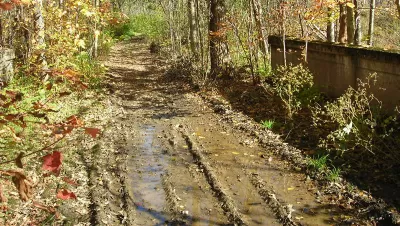Act 178, approved by Vermont in 2006, required that all ancient roads be catalogued by July 1, 2015 to be included in the state map. The exploration of old roads leading up to that deadline makes a compelling story.

Geoff Manaugh reports on a problem of legal history unique to Vermont and the exploration it has inspired.
First the root of the problem:
"In other states, a road that goes unused for a reasonable period of time is legally discontinued; in Vermont, any road that was ever officially entered into a town’s record books remains legally recognized, indefinitely. It doesn’t matter if the road has not been travelled in two hundred years, or if it was never travelled at all, or if it was merely surveyed and never actually built. Any ancient road that exists on paper—unless it has been explicitly discontinued—is considered a public highway in the eye of the law."
Then the response:
"In 2006, prompted by a groundswell of complaints from Vermonters unable to obtain title insurance for their properties or to keep snowmobilers out of their flowerbeds, the state government passed Act 178, which aimed to brush away the infrastructural cobwebs. The act gave the towns until February of 2010 to identify and map any potential ancient roads within their borders; these would then be reviewed by the state and added to Vermont’s official highway map over the next five years. Any ancient road not added to the state map by July 1, 2015, would be considered discontinued."
Act 178 prompted a wave of amateur research on the state's history. The article explores the research findings and methodology of one particularly zealous contributor to that effort, Norman Arsenault.
FULL STORY: Where the Roads Have No Name

Planetizen Federal Action Tracker
A weekly monitor of how Trump’s orders and actions are impacting planners and planning in America.

Restaurant Patios Were a Pandemic Win — Why Were They so Hard to Keep?
Social distancing requirements and changes in travel patterns prompted cities to pilot new uses for street and sidewalk space. Then it got complicated.

Maui's Vacation Rental Debate Turns Ugly
Verbal attacks, misinformation campaigns and fistfights plague a high-stakes debate to convert thousands of vacation rentals into long-term housing.

In California Battle of Housing vs. Environment, Housing Just Won
A new state law significantly limits the power of CEQA, an environmental review law that served as a powerful tool for blocking new development.

Boulder Eliminates Parking Minimums Citywide
Officials estimate the cost of building a single underground parking space at up to $100,000.

Orange County, Florida Adopts Largest US “Sprawl Repair” Code
The ‘Orange Code’ seeks to rectify decades of sprawl-inducing, car-oriented development.
Urban Design for Planners 1: Software Tools
This six-course series explores essential urban design concepts using open source software and equips planners with the tools they need to participate fully in the urban design process.
Planning for Universal Design
Learn the tools for implementing Universal Design in planning regulations.
Heyer Gruel & Associates PA
JM Goldson LLC
Custer County Colorado
City of Camden Redevelopment Agency
City of Astoria
Transportation Research & Education Center (TREC) at Portland State University
Camden Redevelopment Agency
City of Claremont
Municipality of Princeton (NJ)




























